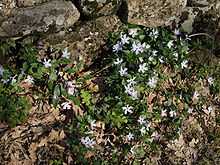Vinca
| Vinca | |
|---|---|
 | |
| Vinca minor | |
| Scientific classification | |
| Kingdom: | Plantae |
| (unranked): | Angiosperms |
| (unranked): | Eudicots |
| (unranked): | Asterids |
| Order: | Gentianales |
| Family: | Apocynaceae |
| Genus: | Vinca L. |
| Species | |
|
Vinca difformis | |
Vinca (/ˈvɪŋkə/;[1] Latin: vincire "to bind, fetter") is a genus of six species in the family Apocynaceae, native to Europe, northwest Africa and southwest Asia.[2][3][4] The English name periwinkle is shared with the related genus Catharanthus (and also with the common seashore mollusc, Littorina littorea). In India the plant is known as sadaphuli meaning "always flowering".
Description

Vinca plants are subshrubs or herbaceous, and have slender trailing stems 1–2 m (3–6 feet) long but not growing more than 20–70 cm (8-30 inches) above ground; the stems frequently take root where they touch the ground, enabling the plant to spread widely. The leaves are opposite, simple broad lanceolate to ovate, 1–9 cm (0.25–3.5 inches) long and 0.5–6 cm (0.25–2.25 inches) broad; they are evergreen in four species, but deciduous in the herbaceous V. herbacea, which dies back to the root system in winter.[5][6]
The flowers, produced through most of the year, are salverform (like those of Phlox), simple, 2.5–7 cm (1–3 inches) broad, with five usually violet (occasionally white) petals joined together at the base to form a tube. The fruit consists of a pair of divergent follicles; a dry fruit which is dehiscent along one rupture site in order to release seeds.[5][6]
Gardens
Two of the species, Vinca major and Vinca minor, are extensively cultivated as a flowering evergreen ornamental plant. Because the plants are low and spread quickly, they are often used as a groundcover in garden landscapes and container gardens. They are also traditionally used in older cemeteries as an evergreen maintenance-free ground cover.[7] Many cultivars are available, with different plant, leaf, and flower - colors, sizes, and habits.
Invasive plant species
Although attractive, both Vinca major and Vinca minor may be mildly invasive in some regions where they are introduced species because of the rapid spreading resulting in choking out native plant species and altering habitats. Areas affected include parts of Australia, New Zealand, and the United States, especially coastal California.[8][9] In other cases, Vinca has been recommended as a fire retardant ground cover.[10] Invasiveness is regionally variable and many vincas do not readily displace native species.[citation needed]
Medicinal use
There are at least 86 alkaloids extracted from plants in the Vinca genus.[11] The chemotherapy agent vincristine is extracted from Vinca rosea (current name Catharanthus roseus), and is used to treat some leukemias, lymphomas, and childhood cancers, as well as several other types of cancer and some non-cancerous conditions. Vinblastine is a chemical analogue of vincristine and is also used to treat various forms of cancer.[12] Dimeric alkaloids such as vincristine and vinblastine are produced by the coupling of smaller indole alkaloids such as vindoline and catharanthine.[13]
References
- ↑ Stearn, W. T. (1983). Botanical Latin ed. 3. David & Charles ISBN 0-7153-8548-8.
- ↑ Flora Europaea: Vinca
- ↑ EuroMed Plantbase Project: Vinca
- ↑ Flora of Pakistan: Vinca
- ↑ 5.0 5.1 Blamey, M., & Grey-Wilson, C. (1989). Flora of Britain and Northern Europe. Hodder & Stoughton.
- ↑ 6.0 6.1 Huxley, A., ed. (1992). New RHS Dictionary of Gardening 4: 664-665. Macmillan.
- ↑ "Periwinkle". Retrieved 16 November 2012.
- ↑ Global Compendium of Weeds: Vinca major
- ↑ Global Compendium of Weeds: Vinca minor
- ↑ Fire-Resistant Plants for Montana Landscapes
- ↑ Manfred Hesse (2002). Alkaloids: Nature's Curse or Blessing?. Wiley-VCH. ISBN 978-3-906390-24-6., p.7
- ↑ American Cancer Society
- ↑ Pharmacognosy of Vinca Alkaloids
External links
| Wikimedia Commons has media related to Vinca. |